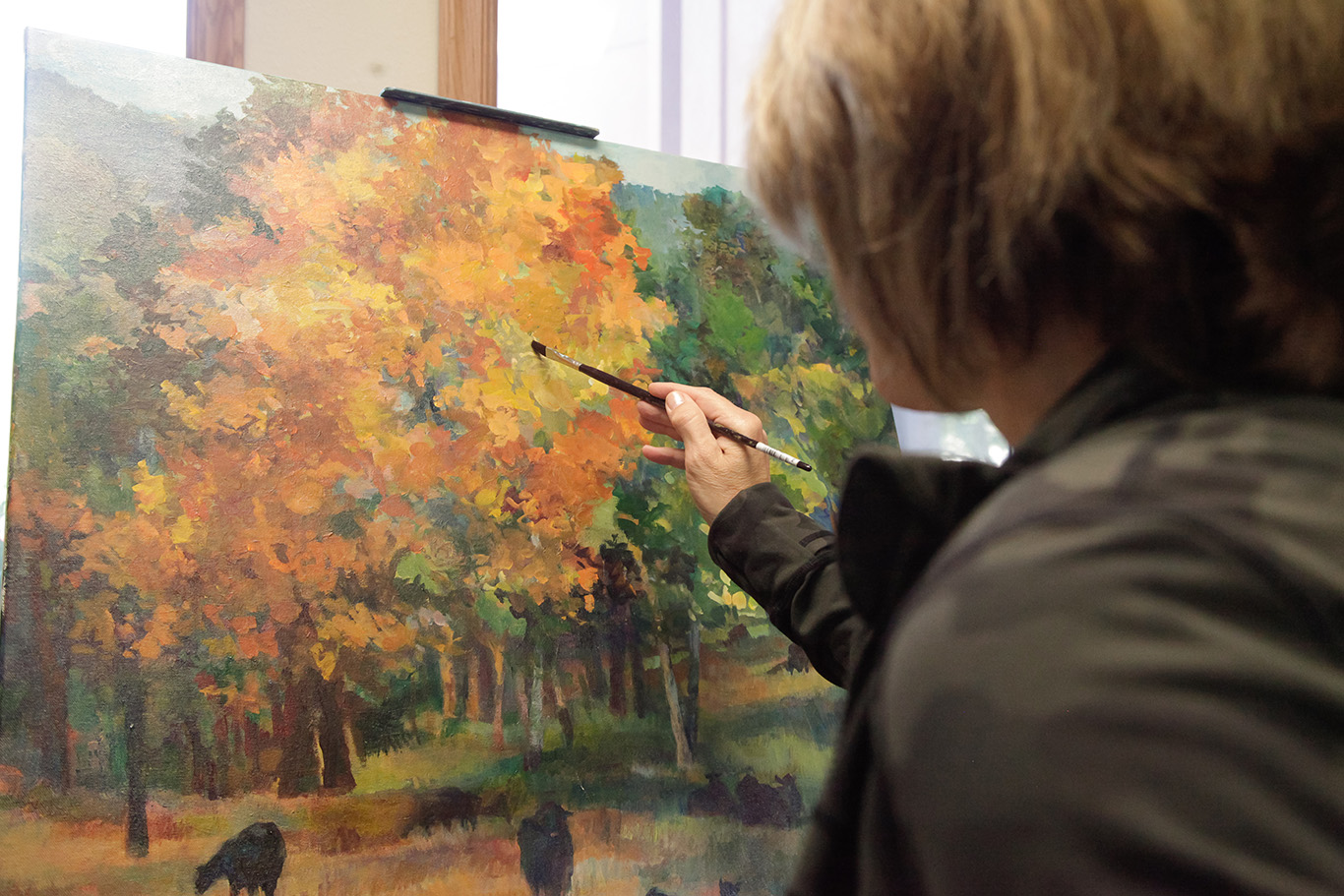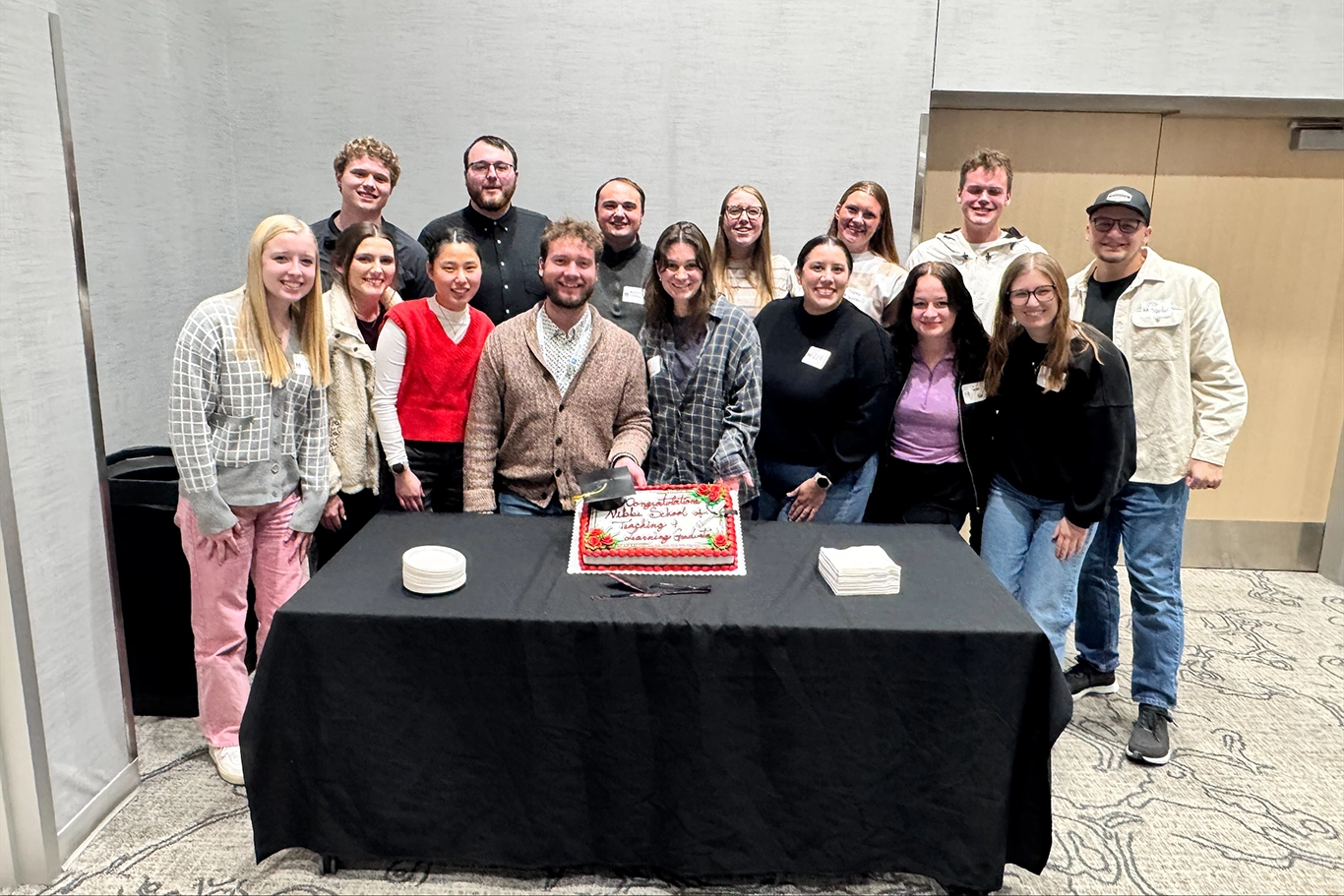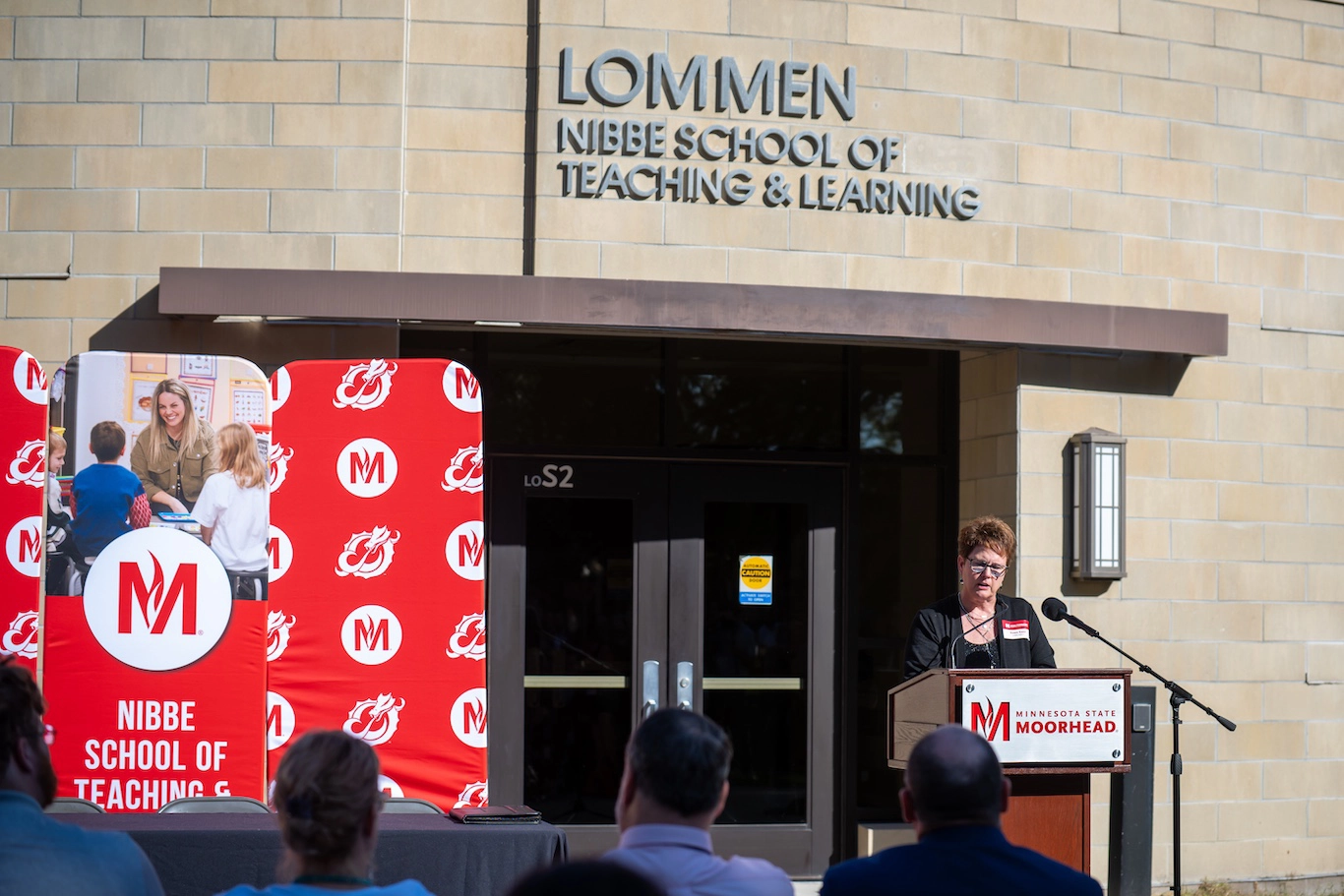Painting to Freedom
Ellen and Paul Diederich's Support Celebrated with Newly Named Art Gallery at MSUM
The colors - rich and deep, bold and bright - catch the eye from across the room.
Move closer, and the colors separate into distinct areas and shades of light playing on the people, animals, lakes and gardens they depict.
Closer still and the vibrance of Midwestern and Southwestern life comes through: the earnest faces of the "Wandering Ewes," boaters launching from "Cormorant Cove" on a summer day, and a "Harvest of Promise" with golden sunflowers in a late September field.
Behind every scene is the artistic sense and vision of Ellen Jean Diederich, a nationally recognized painter who earned a Bachelor of Science in art education and a Bachelor of Fine Arts from Minnesota State University Moorhead in 1983.
Go deeper and it's clear the weighty artistic talent is but the outward expression of a welcoming, generous and caring woman with a dry wit and unrivaled dedication to the process and business of creation.
In honor of Ellen and her husband Paul's generous philanthropy and enduring support of MSUM's School of Art, including a transformative financial gift, the university dedicated the Diederich Art Gallery in the Roland Dille Center for the Arts in October. It marks the first time space in the Roland Dille Center for the Arts bears a name, and it's a lasting testament to their commitment to fostering artistic talent and ensuring future generations have access to high-quality art education at MSUM.
The newly named art gallery will partner with the National Juried Watermedia Exhibition, an annual event organized by the Red River Watercolor Society, an organization Diederich founded with 11 other regional watercolor artists more than 30 years ago. This partnership will further establish MSUM as the region's key cultural and artistic destination.
Down on the Farm
Before that, Diederich was a farm girl in Minnesota. She grew up with a brother and three sisters in Minneapolis. When the family moved to a dairy farm near Staples, they didn't have a television, so each evening when homework, dinner and milking were done, she sewed, played the piano and painted for entertainment. When she finished high school, she said, "I decided to be an artist."
At Moorhead State University, which would change its name to Minnesota State University Moorhead in 2000, Diederich learned to draw caricatures and portraits from Professor Jack Youngquist. The skills she honed there were important not only to her future as a fine artist, but also sustained her in day-to-day life as a financially struggling 1980s college student.
"I lost my job as a nurse's aide, so that weekend I went to a flea market in Detroit Lakes and started drawing caricatures and portraits," she recalls. That day, charging $3 for children and $5 for adults, she made her first $42 as an artist. The money helped keep her in school and art supplies.
"It was really tough, sometimes," she recalls. "I was always broke, so I don't know how I got stuff, but I always had it somehow."
After earning her degrees, she landed a job teaching art to elementary school kids in Pine River, Minn., then returned to Fargo-Moorhead, where she was engaged to Paul Diederich. She hoped to continue teaching art, but no art education positions were available in the community. Paul, meanwhile, was part of the family business, Industrial Builders.
However, she did have a studio, and thanks to Paul's support and stable position, she could dedicate herself entirely to art.
"I thought I'll just start painting," she said. "It was pretty awful at first. I thought I knew how to paint, but what it came down to was painting whatever I wanted to, and I was all over the place. So, in that first year, I learned how to work as an artist."
Raising two daughters, Monica and Brittany, while trying to grow as an artist and a businessperson, presented challenges. But, like everything else in her life, Diederich put her head down and sorted it out.
A big breakthrough came in 1990 with a painting called "Swan Tapestry." In addition to swans, it featured flowers in the background along the edges of a pond. And then there was the water itself.
"How am I going to do this water?" she asked herself. "I looked at books and other artists' water and finally I'm like, 'Well, just do it like Ellen Diederich would do it.' That's what I did, and it was beautiful. And I was like, 'Oh! I have a style!' That was the beginning of my success."
The rest, as they say, is art history.
The Midwestern Impressionist
Diederich paints in her south Fargo, N.D., home studio for part of the year and in Rancho Mirage, Calif., for the rest. She works primarily in watercolor and acrylics, but her interests are wide-ranging and her abilities deep and broad.
The artist calls herself a "Neo-Impressionist," heavily influenced by the original impressionists of the late 1800s and early 1900s but taking impressionism in new directions.
Sotheby's, the multinational art collection and auction house, defines Impressionism as a style that incorporates "...small visible brushstrokes that offer the bare impression of form, unblended color and an emphasis on the accurate depiction of natural light."
Brad Bachmeier, chair of the MSUM School of Art, takes it a step further, describing Diederich as a "Midwest Impressionist."
"Ellen's work definitely has an impressionist sense to it. Her work has a real range of subject matter, exceeding that of most artists. She depicts lake scenes, landscapes, cityscapes, figurative work and genre painting, continually experiments and doesn't easily fit into one category," he said. "A couple of things that impress me most are how prolific she is - she just doesn't stop working - and her immense intellectual curiosity. She's always learning and looking for ways to refine her craft."

Steve Danko, co-owner of Jean Stephen Galleries in Minneapolis with his wife, Jean, sold Diederich's artwork for many years before the couple retired. He agrees.
"Ellen exalts in all the areas of the Midwest, loves being here and loves portraying it in her own artistic way," he said. "It would be hard to find an artist who loves her career more than she does, and she also loves working with people. One might call her a 'people's artist' because that's really what she does and what you can see in her work."
However, it's not all rural folk and their cows, horses and chickens from farms, ranches and coops. Diederich also loves to paint flowers - lots of flowers - landscapes and street scenes from small towns in the Upper Great Plains and villages in the California countryside.
Admirers and friends tell Diederich that they cherish her paintings, and some turn them into heirlooms passed from one generation to the next. At one point a would-be customer offered $10,000 for a painting hanging in her home.
"It was tempting," she says, then gestures to a painting titled "Starry Field" hanging in her living room, "but that was one I had to keep for myself."
Yet some of the most meaningful compliments have come from families whose loved ones have had terminal diseases. The patients have insisted on having their Ellen Diederich paintings in their hospital rooms through their final days, the family members have said, because of the joy and comfort they took from them.
Painting to Live, Living to Paint
It would be tidy to say feedback like that keeps Diederich working, but that's not it at all. The fact is, she simply must paint.
As with many accomplished creators, painting is simply something she cannot live without, like sleeping, eating or breathing. Anniversaries, birthdays, holidays...what makes them special, she says, is being able to paint.
Pieces usually start with a color theme, light and shapes that catch the artist's eye.
"Even when we're traveling, I'm taking pictures, so I'm still doing my art," she explains. "I consider doing my art sketching, drawing, thinking about the colors in a magazine or at the side of a road. I think, 'Oh, I like the colors in that ad! I should do a painting with those colors.' I mean, that's just how it's always there."
Always there and always freeing, she said, in both the literal and figurative senses. Success allows Diederich to direct her own life away from the confines of a typical employment situation, to go where she wants when she wants and do whatever feeds her creative craving. It also allows for experimentation and growth as an artist, pushing herself to try new techniques and explore new subjects.
She speaks of the excitement that comes with ideas forming and taking shape in her mind, and of being "in the zone" when everything aligns and flows through the brushstrokes. But the most important aspect, she said, is consistency.
"I've learned that, with my art, I have to be there every day. So that's what I do."
The self-imposed rule applies not only to creation but also to the business of art.
"I think one factor in Ellen's success is that, unlike most artists, she understands and is very attuned to the business side of art making, including price points, revenue streams, PR and marketing in a way that many artists are not," said Bachmeier, who has served with Diederich on several local art organization boards. "She understands and attends to all of that in very detailed, intentional ways."
That acumen has complimented the artwork itself in bringing acclaim. Prestigious art galleries and societies around the world have accepted Diederich's art. She has signature status with five of them, meaning a society has accepted an artist's work for its exhibitions at least three times.
Perhaps not the least of the honors came in 2016 when MSUM named Diederich one of its Distinguished Alumni of the Year.
From Street Fairs to Sweet Success
Today, Diederich's paintings fetch figures in the thousands, a far cry from the $3 and $5 she made for street caricatures and portraits in the early days. She also sells cards and reproductions on her website.
In addition to painting nearly every day, she's the author of "Progressive Painting: Your Creative Journey," and two children's books about art and creativity: "Sampson's Gift - A Christmas Tradition" and "Where's Petunia?" She also sells cards featuring her art.
Her passions also include supporting new artists and teaching art. The Diederichs have long been MSUM supporters of the arts. They established the Ellen Jean Diederich Art Scholarship, which funds students majoring in art with a focus on painting. She also demonstrates watercolor paintings each year for students in MSUM Professor Zhimin Guan's courses.
"The Diederich's transformative gift not only enhances our academic programming but also elevates our community engagement efforts," said Bachmeier. "With the newly named gallery, we are poised to attract wider audiences to our exhibitions, making the arts at MSUM even more accessible and vibrant. This space will become a cultural hub where students, artists, and community members come together to experience and celebrate artistic innovation."
"I think new artists get scared, and that fear is what ruins people. They start protecting what they have or whatever, worrying about something being good enough instead of just enjoying it and painting it. So it seems that a lot of times they need just a little boost. I love doing that, seeing if I can help someone else along the way," Diederich said.
As for teaching, Diederich is often booked for watercolor and acrylics seminars around the country, and each year she provides a demonstration for art students in MSUM Professor Zhimin Guan's watercolor courses.
To be able to handle it all and still retain focus on her artwork, she has some help. Her sister, Darin Henze, handles framing and card packaging, and Lisa Burns is her executive assistant.
And, of course, every day brings with it more colors, shapes and lighting, and Diederich would like to paint them all.
"I can't even stop," she says. "I see something beautiful, and I want to focus on an aspect of it that I admire and bring that out."
Learn more about Diederich, purchase her art and stay up-to-date with events on her "Painting of the Week" blog at givinity.com and on Instagram. Her work is also available at the Underbrush Gallery, Fargo, the Capital Gallery, Bismarck, and on Fine Art America, where a dozen of her pieces can be purchased as prints or applied to a variety of daily-use items.
The Diederich Art Gallery
The Diederich Art Gallery, located in the Roland Dille Center for the Arts, exhibits art created by regional and national artists, as well as university faculty and students. The gallery is equipped to accommodate a wide variety of media. All events are free and open to the public.
Learn more


